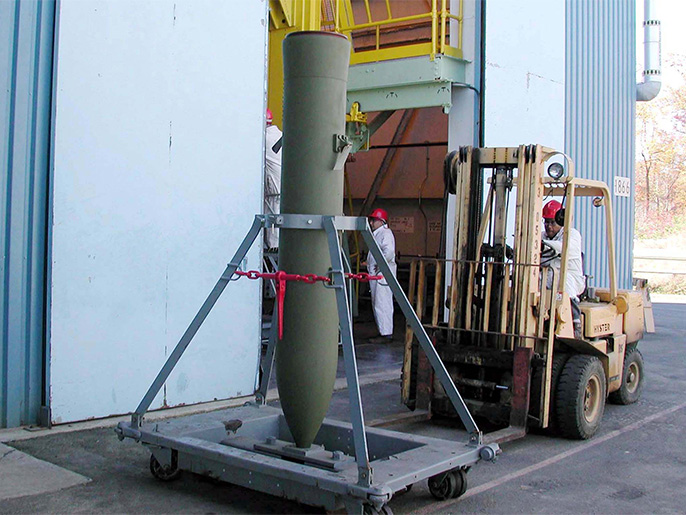Numerous accusations have been leveled against Russia of attacking Ukrainians with cluster bombs and vacuum bombs, weapons that have been condemned by many international organizations.
Two days ago, Ukraine's ambassador to Washington, Oksana Markarova, announced that Russia had used a vacuum bomb in its attacks on Ukraine, a weapon internationally prohibited under the Geneva Convention, just like phosphorous bombs, napalm bombs, fission bombs and cluster bombs.
What is the story of this bomb?
vacuum bomb
A vacuum bomb is a non-nuclear bomb that has a high destructive power.
Vacuum bombs absorb oxygen from the surrounding air to generate an extremely hot explosion, and usually produce a blast wave with a much longer duration than conventional explosives.
The vacuum bomb contains solid fuel ammunition that burns at high speed and turns into a flammable aerosol gas or liquid that absorbs oxygen, and atmospheric pressure attacks from all sides to compensate for the lacking oxygen.
When it explodes, an explosive cloud results in a huge fireball and a great pressure discharge.
The temperature resulting from the detonation process is about three thousand degrees Celsius, which is twice the heat produced by conventional bombs.
The destruction in the targeted area is not limited to the facades of buildings or roofs, but the rear parts of everything that exists are also destroyed.
Even targets that are located underground, such as bunkers, warehouses, and tunnels, are destroyed.
These fortified targets are often not reached by conventional weapons, but the vacuum bomb hits them.
Because the target ocean empties its oxygen, and because of the high temperature generated by the explosion, all neighborhoods will perish by suffocation and burning, and buildings will collapse and collapse.
It causes blindness, concussion of the brain, rupture of the eardrums, in addition to obstruction of the airways, collapse of the lungs, and other very serious injuries.
internationally banned
The vacuum bomb is one of the bombs that are prohibited to be used according to international conventions, as are phosphorous bombs, napalm bombs, fission bombs and cluster bombs.
The Israeli occupation forces used these bombs in the aggression on the Gaza Strip.
Russia has a track record of using this type of weapon much more than the West, and it has such weapons of all sizes and systems, from small tactical weapons to massive air-launched bombs.
2000: The International Human Rights Watch condemned the reported use of these weapons by Russia in Chechnya in 1999, describing it as a "dangerous escalation" with "enormous humanitarian repercussions."
September 2016: Russian and Syrian warplanes launched dozens of raids on the besieged neighborhoods in the city of Aleppo (Northern Syria), as well as several towns in the countryside of the province, using vacuum bombs for the first time, killing 22 people and wounding dozens.
"Father of All Bombs"
2007: Russia says it has successfully tested a non-nuclear airborne bomb, which it describes as the world's most powerful to date.
Alexander Rukshin, Deputy Chief of Staff of the Russian Armed Forces, told Channel One on Russian television that the results of the test of that bomb revealed that its power and effectiveness was equivalent to a nuclear bomb, but that it did not pollute the environment.
Rukshin showed to television what he said was the experiment of detonating the vacuum bomb, where the advanced Tupolev-160 bomber appeared as it dropped the bomb on a test ground to cause an explosion and massive destruction caused by the vacuum charges.
Regarding the technical specifications of the new bomb, a report by Channel One on Russian television said that it carries explosive charges equivalent to seven tons, compared to the eight tons carried by the American bomb, but the strength of the Russian bomb is nevertheless equivalent to the strength of four American bombs.
The Russian Defense Ministry attributed this to the high quality of explosives carried by the Russian bomb using nanotechnology.
Moscow called the vacuum bomb the "father of all bombs" compared to the description the United States gave its most powerful vacuum bomb in the world in 2003, which it called "the mother of all bombs."
2014: Russian-backed separatists in the Donbas region have used such weapons for several years.
America also used vacuum bombs in its war against Al-Qaeda in Afghanistan at the end of 2001, especially those known as "BLU-118/B".
Bomb Specifications (BLU-118/B)
Warhead: piezothermal.
Guidance: be laser or missile, according to specific technical systems.
Weight: from 895 to nine hundred kilograms approximately.
Length: 2.5 meters.
Diameter: 0.36 metres.
Weight of the explosive payload: 254 kilograms.
Bomber aircraft: F-15E.
"Mother of All Bombs"
- April 2017: The US army dropped what it called the "mother of all bombs" in Nangarhar province, eastern Afghanistan, targeting caves and hideouts for the Islamic State, and the US army published footage of the bombing operation.
The Afghan Ministry of Defense said that 36 ISIS militants were killed after the US "mother of all bombs" was thrown in Achin district of Nangarhar province.
The "mother of all bombs" carries explosives weighing eleven tons of TNT, and the length of the bomb is about nine meters.
A few days later, Russian media revealed that Moscow possesses a non-nuclear bomb, which it described as the most powerful in the world so far.
She added that the power of the Russian bomb is equivalent to four American bombs.
According to CNN, Moscow called its vacuum bomb “the father of all bombs,” similar to the description that America gave to its “mother of all bombs.”
The Russian bomb is smaller than the American one, but it is more destructive because of the intense heat produced by its detonation.

